Types of Progress Reports Seniors Receive in Hybrid Care Programs

Understanding Progress Reports in Hybrid Senior Care
As healthcare increasingly shifts toward hybrid models that combine in-person and remote services, the importance of effective progress reporting for seniors cannot be overstated. These reports serve as vital tools for tracking health status, guiding care interventions, and evaluating outcomes, ensuring seniors receive personalized and coordinated care regardless of the setting.
Overview of the Types of Progress Reports in Hybrid Care Programs

What are the different types of progress reports provided to seniors in hybrid care programs?
In hybrid healthcare programs, progress reports serve as vital tools to monitor, evaluate, and communicate the health and well-being of older adults. These reports typically fall into three main categories: assessment reports, intervention reports, and evaluation reports.
Assessment reports focus on documenting the current health status of seniors. They include vital signs such as blood pressure and heart rate, assessments of symptoms management, and chronic disease monitoring. Functional abilities are also evaluated, covering mobility, ability to perform daily activities, and cognitive functions. Social aspects, like emotional well-being, social engagement, and access to community resources, are often incorporated to paint a holistic picture of the senior's health.
Intervention reports detail the care plans and the adherence to prescribed treatments. These include medication management, attendance at scheduled appointments, participation in health education sessions, and lifestyle modifications like diet and exercise routines. They help care teams understand how well agreed-upon strategies are being followed and identify areas needing adjustment.
Evaluation reports, on the other hand, measure the outcomes of the interventions and overall care quality. These reports typically assess changes in health indicators, improvements in functional abilities, and the attainment of personal health goals. They may also analyze broader metrics such as hospitalization rates, falls, medication adherence, and quality of life.
Formats and Delivery of Progress Reports
These reports are delivered through various formats to maximize clarity and accessibility. Common methods include:
- Written summaries compiled into comprehensive reports or brief updates.
- Digital dashboards accessible via secure online portals for real-time monitoring.
- Verbal updates provided during telehealth consultations or in-person visits.
This combination ensures that seniors, their families, and healthcare providers stay informed and engaged in the care process, enhancing communication and supporting better health outcomes.
Objectives and Purposes of Progress Reports
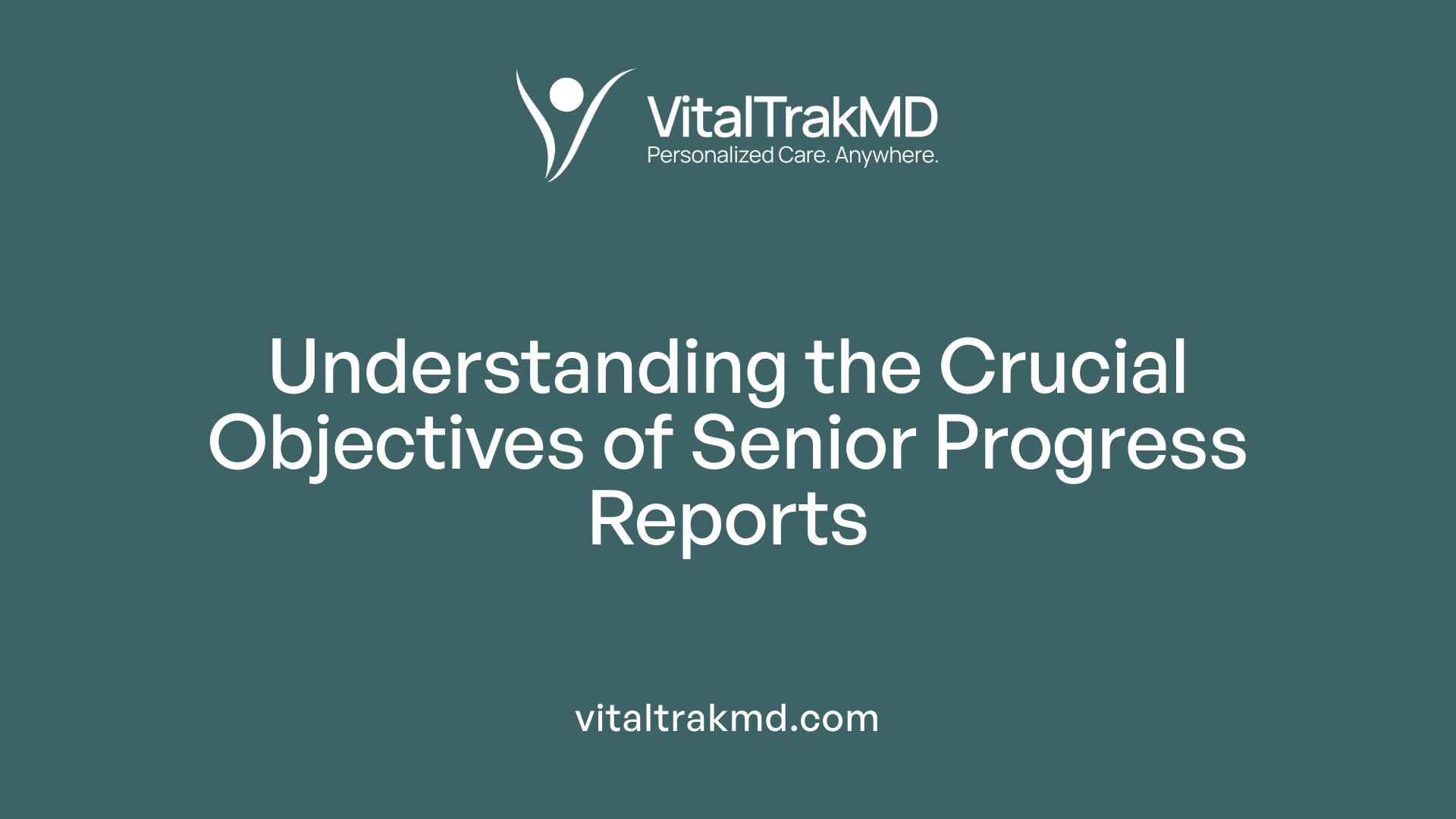
What are the purposes and objectives of progress reports for seniors in hybrid care settings?
Progress reports play a crucial role in the management of senior healthcare, especially within hybrid care models that combine in-person and digital health services. Their primary purpose is to monitor the health progression of older adults accurately. Through systematic documentation of assessments, interventions, and outcomes, these reports help caregivers and healthcare professionals track the effectiveness of ongoing care plans.
One key objective is to enable timely adjustments to individualized care strategies. By identifying early signs of deterioration or improvement, care teams can modify treatments or support measures accordingly, ensuring better health outcomes.
Another vital function of progress reports is to foster consistent communication among all members of a multidisciplinary care team. These documents serve as a shared source of information, promoting coordinated efforts across different health and social service providers.
Moreover, progress reports are instrumental in enhancing patient engagement and satisfaction. Providing seniors with feedback about their health progress encourages active participation in their own care, empowering them to make informed decisions. This transparency builds trust and motivation, which can lead to better adherence to care plans.
In addition, these reports assist in early detection of potential issues or setbacks. By systematically reviewing progress data, care professionals can promptly identify areas needing additional support or intervention, reducing the risk of complications.
Overall, progress reports in hybrid care settings aim to support continuous, personalized care. They leverage digital tools and in-person services to optimize the health and well-being of seniors, ensuring that care delivery remains responsive and effective.
Content and Scope Encompassed in Senior Progress Assessments
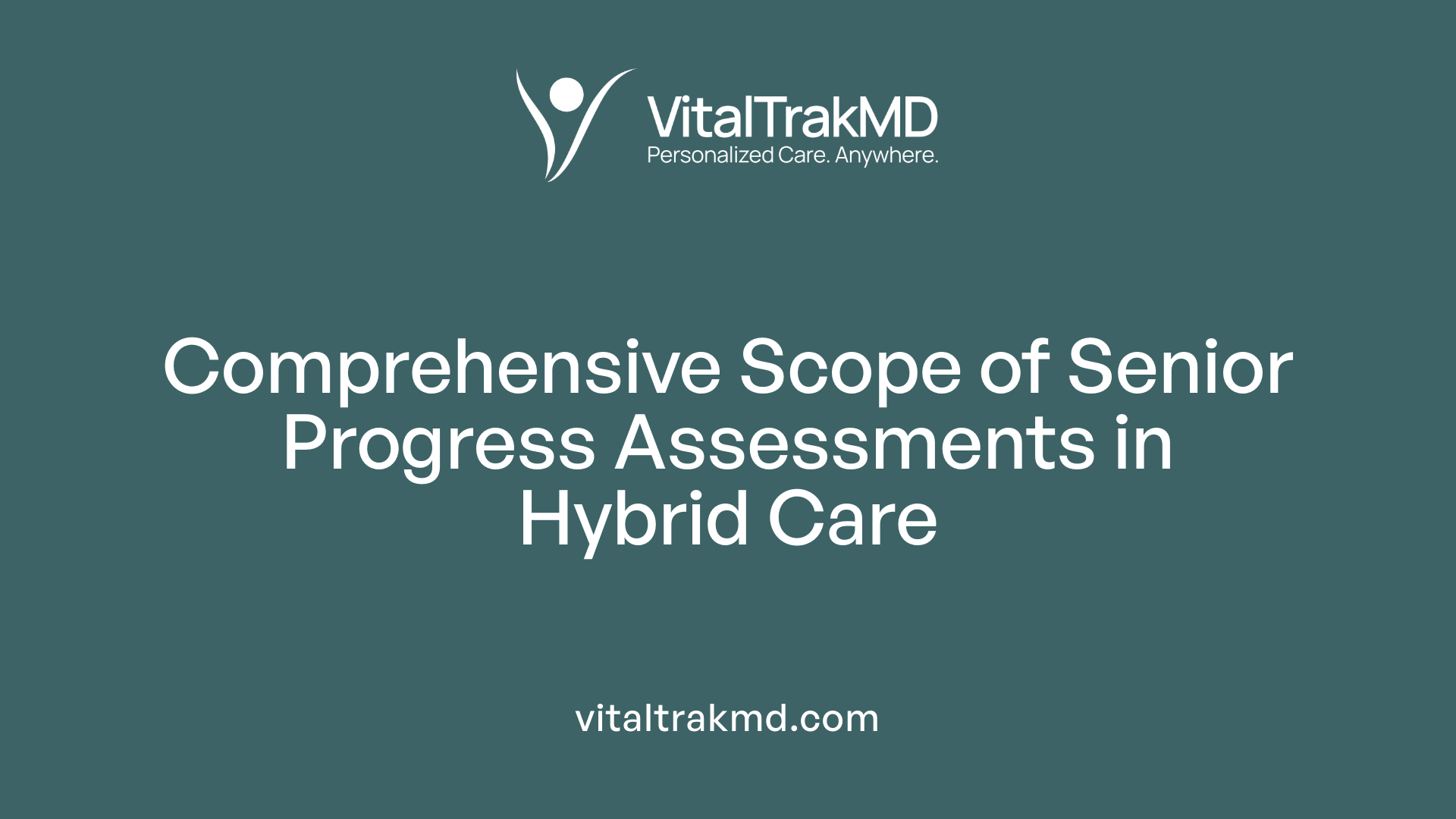
What content and scope are typically included in senior progress assessments in hybrid care?
Senior progress assessments in hybrid healthcare settings are comprehensive evaluations designed to monitor and enhance older adults’ health and well-being through a combination of virtual and in-person methods. These assessments typically cover various aspects of the patient's health and social circumstances to form a detailed picture that guides ongoing care.
Primarily, assessments include vital signs such as blood pressure, heart rate, and temperature, which can often be measured remotely with specialized monitoring tools. Blood pressure control is especially important for seniors with hypertension, as maintaining measures below 140/90 mm Hg is a common target. Clinicians also evaluate current medications and any recent laboratory results, including assessments like BI-RADS following mammograms, and follow-up procedures after abnormal results.
Functional and cognitive evaluations form a core component of the assessment. These involve reviewing activities of daily living (ADLs), instrumental activities (IADLs), cognitive function tests, and screening for depression or confusion. These evaluations help identify any decline or changes that may require intervention.
Social and environmental considerations are also integrated. Clinicians assess factors such as home safety, social support networks, and environmental risks—like fall hazards or unsafe living conditions—that could impact health outcomes. Understanding these factors enables tailored care plans that address both medical and social needs.
Care plan adherence is reviewed by examining a patient’s compliance with prescribed treatments, participation in health education or coaching, and follow-up appointments. Technology, such as telehealth platforms, facilitates remote assessments, allowing clinicians to perform physical inspections and discussions via video calls, thereby ensuring continuous monitoring without the need for frequent in-person visits.
Environmental safety issues, logistical barriers, and support systems are part of the assessment to identify potential challenges in managing health at home. This integrated approach ensures that the assessment captures a holistic view of the older adult’s health status and environmental context.
In sum, senior progress assessments in hybrid care are designed to be thorough and adaptable, combining real-time data, patient input, and remote observations. They help healthcare professionals deliver personalized, effective support, optimizing health outcomes and quality of life for older adults.
Methods for Monitoring and Evaluating Seniors' Health in Hybrid Programs
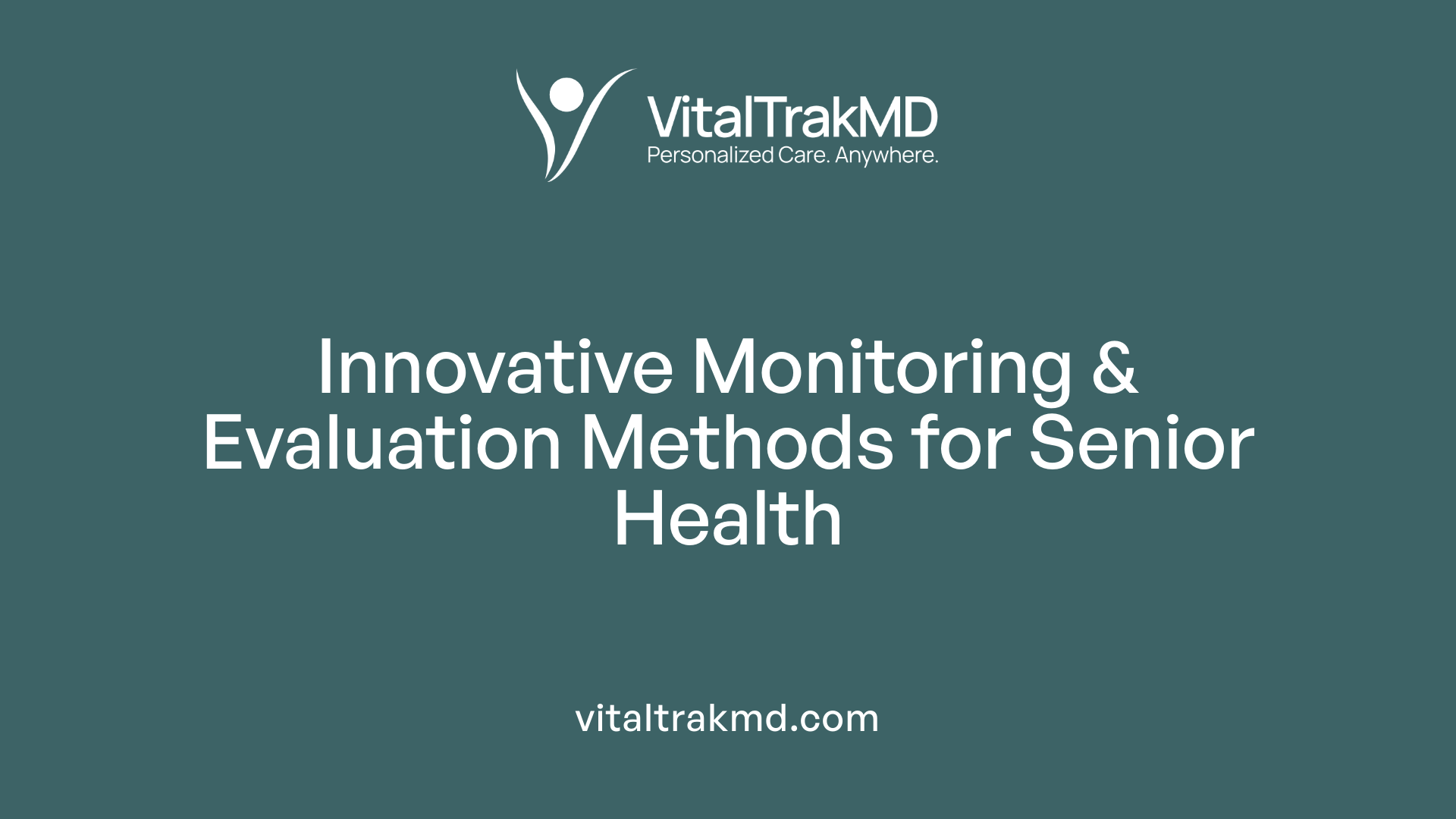
What methods are used to monitor and evaluate seniors in hybrid healthcare programs?
In hybrid healthcare settings, monitoring and assessing seniors' health involves a mix of innovative technologies and systematic evaluation processes. One primary approach is the collection of biometric data using advanced sensing devices. These include biosensors that measure vital signs such as blood pressure, electroencephalograms (EEG), and electrocardiograms (ECG). These devices continuously record physiological signals, providing real-time health insights.
Environmental sensors also play a critical role. These sensors detect changes in gas levels, smoke, temperature, and humidity, which can indicate potential hazards or health issues within a senior’s living environment. Location and activity monitoring are facilitated through environmental sensors embedded in smart home systems or wearable devices. This setup allows for tracking movement, identifying activity patterns, and determining the senior’s location within different zones of the home.
To interpret this wealth of data, assessment algorithms like the Expectation-Maximization (EM) algorithm are utilized. These algorithms analyze biometric and environmental data to generate a health risk ratio. This helps categorize the senior’s current health status and predict potential risks, enabling personalized care and timely interventions.
Monitoring extends beyond data collection to the evaluation of system performance. Continuous checks involve automated systems that flag anomalies and human oversight to interpret complex data. The evaluation framework emphasizes safety, clinical appropriateness, and empathy—mirroring standards used in AI health applications—to ensure that technological integration benefits seniors without compromising quality of care.
Regular reviews of system accuracy and safety protocols ensure that the technology adapts to changing needs and maintains trustworthiness. This iterative process supports both the proactive management of health conditions and the overall well-being of older adults in hybrid healthcare environments.
Overall, these multimodal and data-driven methods foster a comprehensive, dynamic evaluation system that enhances the quality and safety of seniors’ healthcare through technological innovation and thoughtful oversight.
Preparation, Scheduling, and Data Collection of Progress Reports

How are progress reports for seniors typically prepared and scheduled in hybrid care models?
Progress reports for older adults in hybrid health care settings are generally prepared through systematic collection and analysis of various clinical data points. This includes vital signs, laboratory results, assessment findings, and follow-up actions, all documented during hospital visits, community health encounters, or via remote monitoring devices.
For these reports, health care providers often rely on structured data collection frameworks such as the Omaha System, which supports consistent documentation of assessments, interventions, and evaluations. This structured approach ensures comprehensive data capture, facilitating accurate monitoring of patient progress and outcomes.
Schedule-wise, these reports are typically prepared on a regular basis—monthly or quarterly—depending on the program’s requirements and reporting obligations. For example, in some initiatives, progress reports are aligned with fiscal or calendar reporting periods, such as beginning from July 1st, 2025. Regular scheduling helps maintain continuous oversight and timely intervention adjustments for seniors.
The reporting process involves generating specific data files, like Quality Reporting Data Architecture (QRDA) I or other electronic data submissions, containing important linking variables and clinical data elements. Before submitting these reports, data undergo validation to ensure completeness, accuracy, and consistency.
With the increasing adoption of Electronic Clinical Data Systems (ECDS), reporting now benefits from automated data extraction and integration, which enhances data quality and reduces manual workload. Digital measures allow for full population reporting, supporting healthcare providers and administrators to efficiently track senior health outcomes, assess program fidelity, and inform future care strategies.
Overall, the evolution towards fully integrated electronic systems and standardized reporting frameworks has made the preparation and scheduling of progress reports more streamlined, timely, and precise—ultimately supporting better care delivery for older adults in hybrid health models.
Documentation and Forms Involved in Managing Senior Progress Reports
 Managing senior progress reports in hybrid care programs requires careful compilation of various documentation and forms that systematically record patient progress and support care quality. These include assessment forms, care plan updates, medication review templates, and overall health records, which are often stored and accessed through electronic health record (EHR) systems.
Managing senior progress reports in hybrid care programs requires careful compilation of various documentation and forms that systematically record patient progress and support care quality. These include assessment forms, care plan updates, medication review templates, and overall health records, which are often stored and accessed through electronic health record (EHR) systems.
EHR systems serve as central hubs for documentation, enabling healthcare providers to input, update, and retrieve essential information efficiently. These records facilitate seamless communication among multidisciplinary teams and ensure that all relevant clinical data is available for decision-making.
In addition to documentation stored within EHRs, hybrid programs leverage claims data and detailed clinical data elements (CCDEs). CCDEs encompass vital signs, laboratory results, medication lists, and patient demographic details. These data points are crucial for monitoring clinical outcomes, such as readmission rates, adherence to treatment, and mortality statistics.
The reporting process often involves transmitting QRDA I (Quarterly Report Data Architecture) files. These files contain structured information about patient outcomes and clinical measures that meet specific timing and schema protocols. The QRDA I format ensures consistent, accurate data transfer aligned with national measurement and reporting standards.
Validation of data accuracy and completeness is an essential step in managing senior progress reports. This process involves initial review and testing of data submissions to identify discrepancies, ensure completeness, and verify compliance with reporting requirements. Validation procedures help maintain data integrity, which is vital for accurate outcome measurement and quality improvement.
Overall, structured documentation combined with standardized data collection and secure transmission protocols underpins the effective management of senior progress reports in hybrid care settings. These processes enable healthcare providers to monitor patient progress, evaluate care effectiveness, and support continuous quality improvement initiatives.
Contribution of Progress Reports to Care Quality and Outcomes Evaluation
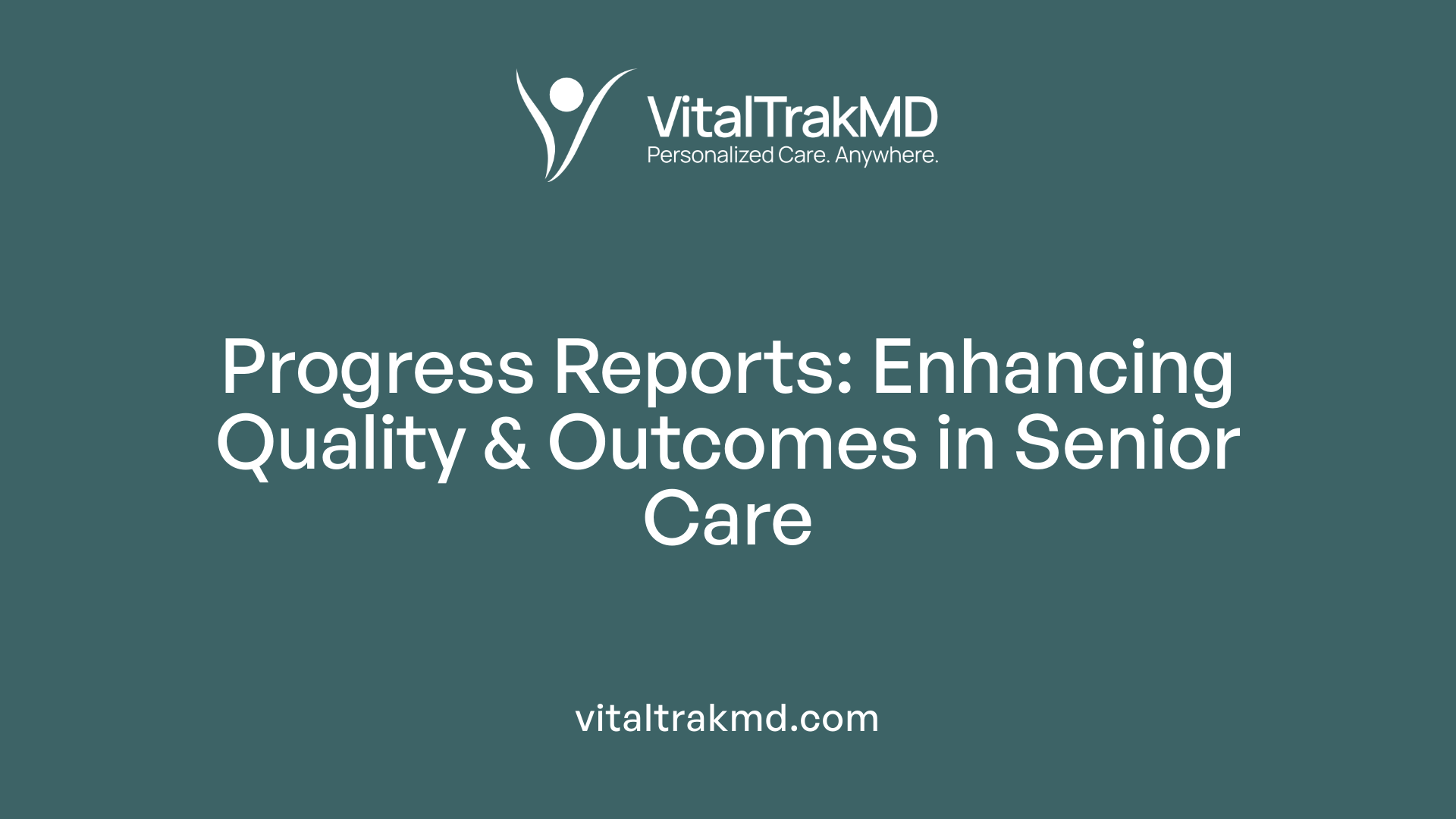
How do progress reports contribute to assessing the quality and outcomes of senior care in hybrid models?
Progress reports are essential tools in evaluating the effectiveness and safety of senior care, particularly within hybrid models that combine different service approaches such as consumer-directed and professional management systems.
These reports standardize data collection by consolidating information from various sources like assessments, interventions, and evaluations. For seniors, this includes documentation from tools such as the Omaha System or the MDS, which track health conditions, self-care capacity, and social support. By providing a uniform structure, progress reports facilitate comparison across different programs and service models, making it easier to identify strengths and weaknesses.
Transparency and accountability are also bolstered through these reports. Publicly available or internally reviewed progress data promote trust and motivate providers to maintain or improve care quality. For instance, regular reporting on safety concerns, hospital readmissions, and patient satisfaction ensures that stakeholders can monitor performance over time.
Moreover, progress reports enable ongoing monitoring of care safety, effectiveness, and equity. They highlight disparities among subgroups, such as minority or high-risk seniors, allowing targeted interventions to improve health outcomes. These reports also track adherence to clinical guidelines, such as blood pressure control or follow-up after abnormal screenings, which directly influence patient health and safety.
System performance evaluation is another crucial aspect. Progress reports include metrics on staff training, resource allocation, and accessibility of services. These factors are vital for ensuring that care delivery meets quality standards and for identifying areas needing improvement.
Finally, comprehensive reporting supports policy development and quality improvement initiatives. By analyzing aggregated data, healthcare authorities can implement evidence-based strategies to optimize resource use, reduce disparities, and enhance overall care effectiveness.
| Aspect of Evaluation | Role of Progress Reports | Benefits |
|---|---|---|
| Data collection | Standardize clinical and social data | Consistent measurement of outcomes |
| Transparency | Public reporting and provider accountability | Improved trust and motivation |
| Monitoring safety | Track adverse events and safety perceptions | Reduce risks and improve patient confidence |
| Effectiveness assessment | Measure clinical outcomes like blood pressure control | Enhance treatment protocols |
| Equity analysis | Identify care disparities among subpopulations | Targeted interventions |
| System performance | Evaluate resource allocation and staff training | Optimized care delivery |
In summary, progress reports are integral to a comprehensive assessment system. They promote continuous improvement by providing detailed, consistent, and transparent data, ultimately leading to higher quality and more equitable senior care in hybrid service models.
Progress Report Formats: Digital, Paper, and Verbal Updates
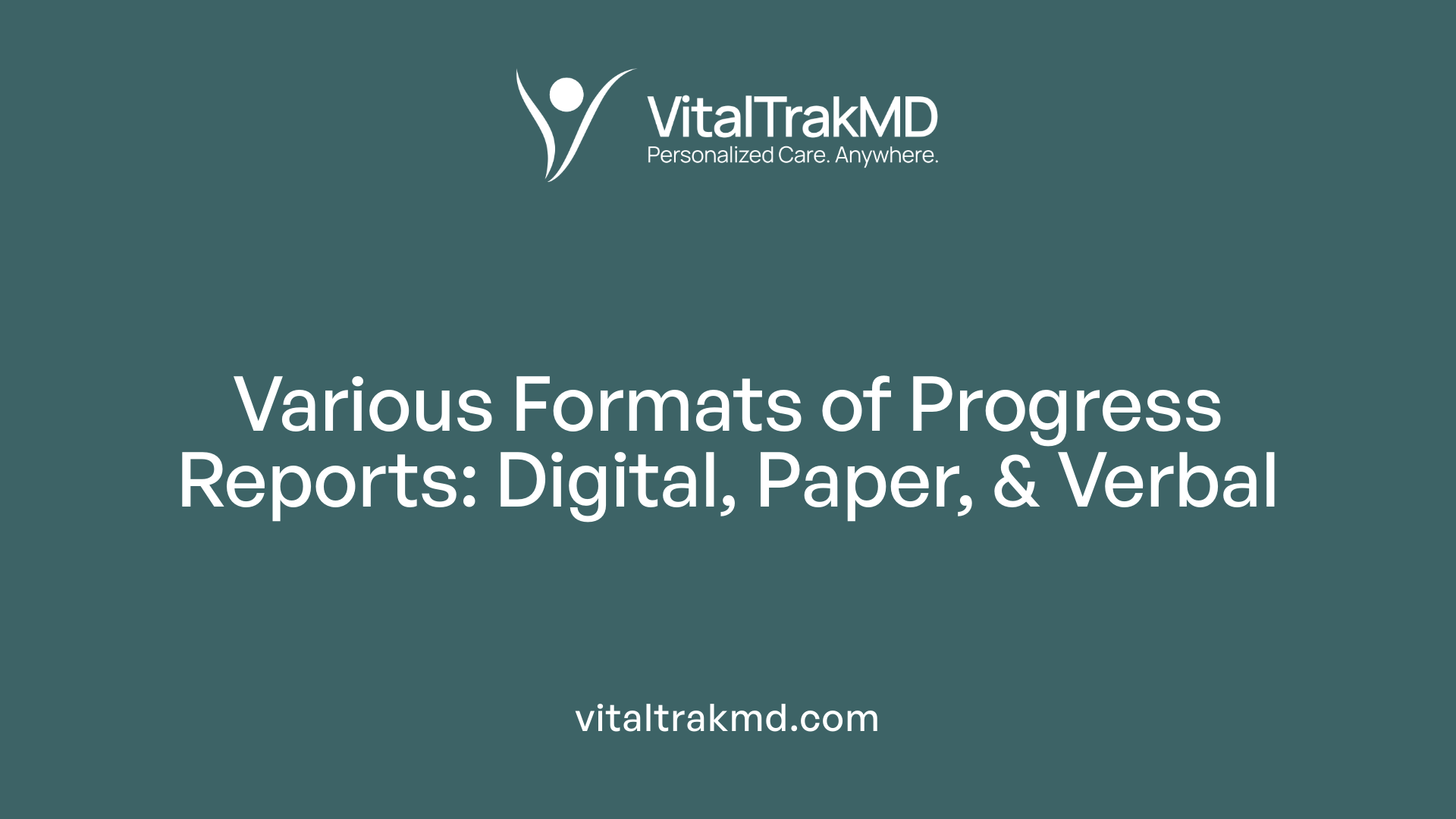
What types of written summaries and detailed reports are used in hybrid senior care?
In hybrid senior care programs, structured written reports are essential for maintaining continuous, quality care. These often include progress notes that record day-to-day updates following each visit or intervention. Detailed reports like comprehensive assessment summaries condense vital information gathered over time, including health status, treatment plans, and care outcomes.
Healthcare providers frequently employ standardized formats such as SOAP (Subjective, Objective, Assessment, Plan) or STAR (Situation, Task, Action, Result) to ensure thorough documentation. These summaries are typically integrated into electronic health records (EHRs) to promote easy access and consistency. Such reports not only support clinical decision-making but also ensure legal and regulatory compliance.
How are digital dashboards used to monitor senior care remotely?
Digital dashboards have transformed how caregivers and healthcare teams monitor older adults in hybrid models. These dashboards are accessible through secure portals, providing real-time data on client status, medication adherence, activity levels, and social engagement.
By consolidating data from multiple sources—such as wearable devices, medication logs, and electronic health records—these dashboards offer an at-a-glance overview of each senior’s health trajectory. Care teams can identify early warning signs of deterioration or adverse events promptly, facilitating timely interventions.
What role do verbal updates play in hybrid senior care?
Verbal updates remain a vital component in hybrid care settings, especially during telehealth consultations and face-to-face visits. Care providers, family members, and the seniors themselves often exchange verbal reports to discuss recent changes, concerns, or responses to treatment.
These verbal updates offer a flexible, immediate means of communication that complements written and digital reports. They are particularly valuable for capturing nuanced observations and emotional states that may not be fully documented in written formats.
Are there examples of progress report types used in specific hybrid senior care initiatives?
Yes, many programs incorporate various report types to support effective care delivery. Digital tools like electronic progress notes and dashboards are commonly used to track health and support issues remotely.
Support staff frequently utilize structured formats like SOAP or STAR during visits or shifts to ensure accurate and comprehensive documentation. For regular summaries, care teams prepare comprehensive reports that encompass data from digital records and paper forms, aiding coordination.
These different report types enhance communication among caregivers, support legal compliance, and uphold quality standards in hybrid senior care models. They also provide a foundation for evaluating intervention effectiveness and planning future care strategies.
Overview of report formats in hybrid models
| Report Type | Usage Context | Format/Tools | Purpose |
|---|---|---|---|
| Written summaries | Daily, weekly care assessments | SOAP, STAR formats | Document client progress and support clinical decisions |
| Digital dashboards | Continuous monitoring | Real-time data visualization | Track health trends, alert to risks |
| Verbal updates | Telehealth and in-person visits | Interviews, discussions | Share immediate observations and client feedback |
| Comprehensive reports | Care coordination meetings | Combined data from various inputs | Summarize overall client status and plan care strategies |
These diverse reporting formats work together to create a comprehensive picture of each senior’s health, enabling personalized, timely, and effective care in hybrid settings.
Best Practices and Guidelines for Preparing Senior Progress Reports
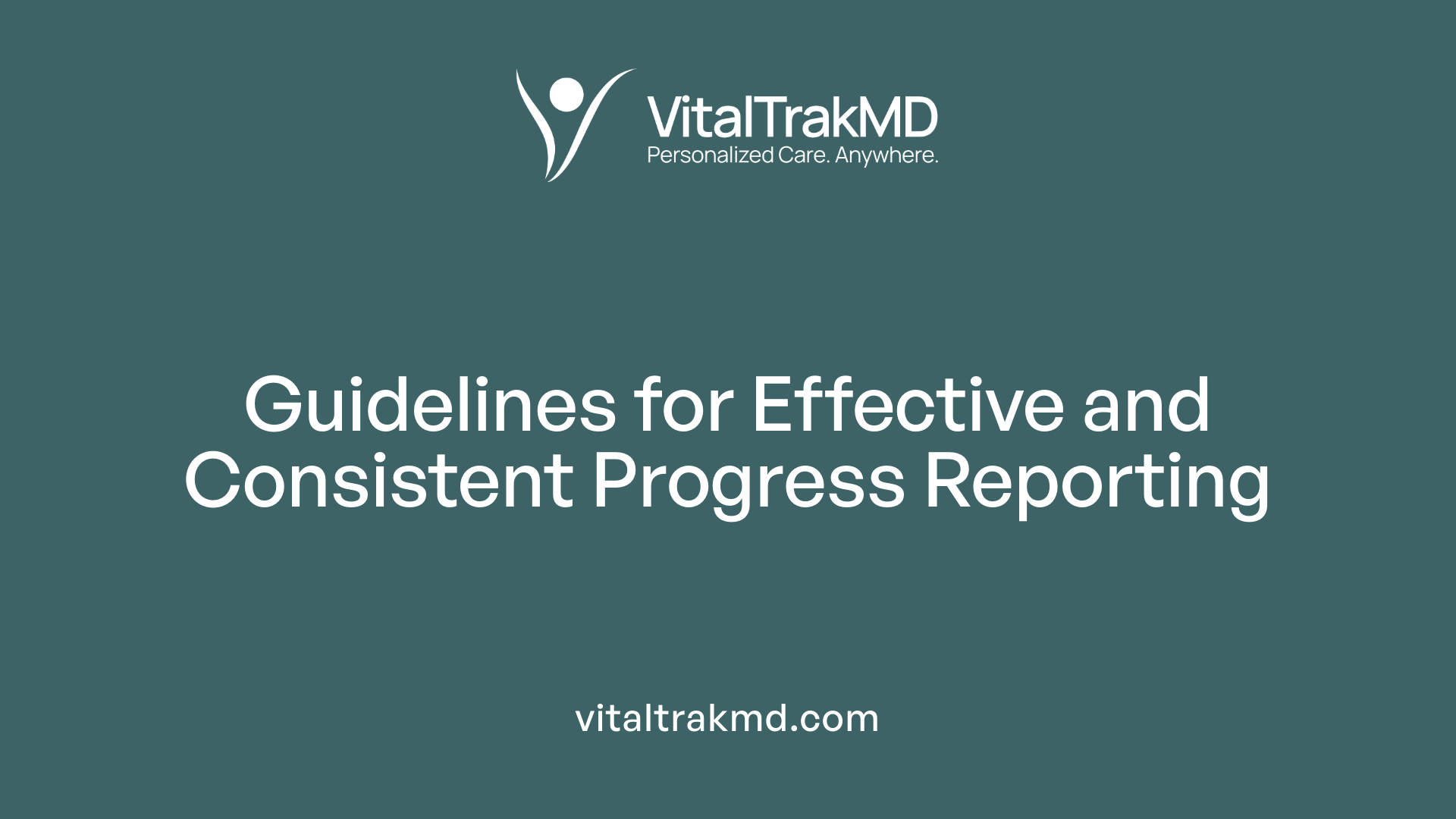
What are the best practices and guidelines for preparing and utilizing senior progress reports in hybrid healthcare?
In hybrid healthcare environments, where both in-person and remote care are integrated, the creation and use of senior progress reports should be guided by several best practices to maximize their effectiveness.
Firstly, establishing standardized data collection protocols is essential. This ensures that the information collected from various sources, such as clinical assessments, self-reports, and caregiver inputs, is consistent and accurate. Using clear definitions and standardized forms helps reduce errors and variability.
Next, regularly updating these reports is crucial. As health statuses can change quickly, timely updates allow healthcare teams to have the most current information. This enables prompt adjustments to care plans and intervention strategies, which is especially important for managing chronic conditions common among seniors.
Integration with Electronic Health Record (EHR) systems plays a vital role in seamless information sharing. Embedding progress reports into existing digital platforms makes data accessible to all relevant team members. It also promotes routine use of the reports, enhancing coordination and reducing duplication of efforts.
Training healthcare staff on how to interpret and apply progress report data can significantly improve outcomes. Well-trained staff can better identify issues, gauge progress, and make informed decisions about treatment adjustments. Training should also include understanding the importance of caregiver and senior involvement.
Finally, involving seniors and their caregivers directly in discussions about progress reports fosters transparency. It supports shared decision-making, ensuring that care plans are personalized and aligned with the senior’s preferences and needs. Engaging patients in their own health tracking also encourages compliance and enhances satisfaction.
Following these guidelines helps create meaningful progress reports that not only document health changes but also serve as active tools for improving the quality of senior care in hybrid settings.
Conclusion: The Significance of Robust Progress Reporting
Effective and comprehensive progress reports are fundamental to the success of hybrid senior care programs. They serve not only as tools for clinical oversight but also as instruments for quality improvement, accountability, and personalized care delivery. Embracing advancements in digital reporting formats and adhering to best practices ensures that seniors receive coordinated, responsive, and high-quality care across settings. Continuous refinement of reporting standards and methods will be vital as healthcare models evolve to meet the complex needs of an aging population.
References
- HEDIS MY 2025: What's New, What's Changed, What's Retired
- Community-Based Health-Social Partnership Programme (C-HSPP ...
- [PDF] Submitting Progress Reports Litmos Courses - AmeriCorps
- 10 Things to Know About Medicaid Managed Care - KFF
- A community-based health–social partnership program for ...
- In-Home Supportive Services for the Elderly and Disabled
- Prepping for Hybrid Measure Submissions - Medisolv Blog
- Expanding Access to Comprehensive Geriatric Evaluation via ...
- Expanding Access to Comprehensive Geriatric Evaluation via ...
Recent articles
Want to Feel Better and Live Healthier?
Join hundreds of patients taking control of their health with personalized care that fits their life – not the other way around.
Rated 4.8/5 by 32+ customers







